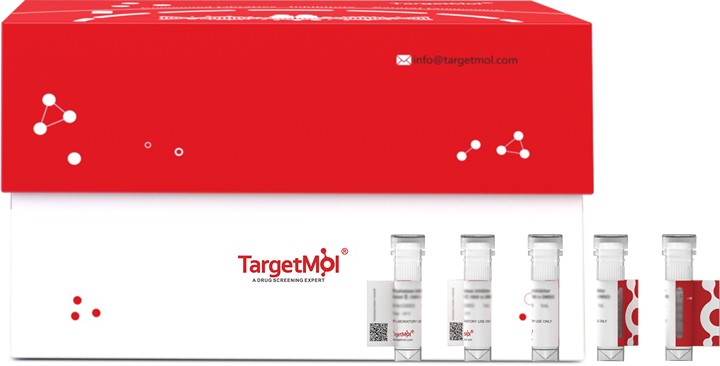- Remove All
 Your shopping cart is currently empty
Your shopping cart is currently empty
MAX Protein, Human, Recombinant (His & GST)
MYC associated factor X contains 1 basic helix-loop-helix (bHLH) domain and belongs to the MAX family. It is highly expressed in the brain, heart, and lung while lower levels are seen in the liver, kidney, and skeletal muscle. MYC associated factor X can form homodimers and heterodimers with other family members, which include Mad, Mxi1, and Myc. Myc is an oncoprotein implicated in cell proliferation, differentiation, and apoptosis. The homodimers and heterodimers compete for a common DNA target site (the E box) and rearrangement among these dimer forms provides a complex system of transcriptional regulation. MYC associated factor X may also repress transcription via the recruitment of a chromatin remodeling complex containing H3 'Lys-9' histone methyltransferase activity. Multiple alternatively spliced transcript variants have been described for MYC associated factor X gene but the full-length nature for some of them is unknown.

MAX Protein, Human, Recombinant (His & GST)
| Pack Size | Price | Availability | Quantity |
|---|---|---|---|
| 50 μg | $398 | 7-10 days |
Product Information
| Biological Activity | Activity testing is in progress. It is theoretically active, but we cannot guarantee it. If you require protein activity, we recommend choosing the eukaryotic expression version first. |
| Description | MYC associated factor X contains 1 basic helix-loop-helix (bHLH) domain and belongs to the MAX family. It is highly expressed in the brain, heart, and lung while lower levels are seen in the liver, kidney, and skeletal muscle. MYC associated factor X can form homodimers and heterodimers with other family members, which include Mad, Mxi1, and Myc. Myc is an oncoprotein implicated in cell proliferation, differentiation, and apoptosis. The homodimers and heterodimers compete for a common DNA target site (the E box) and rearrangement among these dimer forms provides a complex system of transcriptional regulation. MYC associated factor X may also repress transcription via the recruitment of a chromatin remodeling complex containing H3 'Lys-9' histone methyltransferase activity. Multiple alternatively spliced transcript variants have been described for MYC associated factor X gene but the full-length nature for some of them is unknown. |
| Species | Human |
| Expression System | Baculovirus Insect Cells |
| Tag | His, GST |
| Accession Number | P61244-1 |
| Synonyms | MYC associated factor X,bHLHd4 |
| Construction | A DNA sequence encoding the human MAX (NP_002373) (Met1-Ser160) was fused with the N-terminal polyhistidine-tagged GST tag at the N-terminus. Predicted N terminal: Met |
| Protein Purity | > 85 % as determined by SDS-PAGE |
| Molecular Weight | 46.1 kDa (predicted); 73 kDa (reducing conditions) |
| Endotoxin | < 1.0 EU/μg of the protein as determined by the LAL method. |
| Formulation | Lyophilized from a solution filtered through a 0.22 μm filter, containing 20 mM Tris, 500 mM NaCl, pH 8.0, 10% gly. Typically, a mixture containing 5% to 8% trehalose, mannitol, and 0.01% Tween 80 is incorporated as a protective agent before lyophilization. |
| Reconstitution | A Certificate of Analysis (CoA) containing reconstitution instructions is included with the products. Please refer to the CoA for detailed information. |
| Stability & Storage | It is recommended to store recombinant proteins at -20°C to -80°C for future use. Lyophilized powders can be stably stored for over 12 months, while liquid products can be stored for 6-12 months at -80°C. For reconstituted protein solutions, the solution can be stored at -20°C to -80°C for at least 3 months. Please avoid multiple freeze-thaw cycles and store products in aliquots. |
| Shipping | In general, Lyophilized powders are shipping with blue ice. |
| Research Background | MYC associated factor X contains 1 basic helix-loop-helix (bHLH) domain and belongs to the MAX family. It is highly expressed in the brain, heart, and lung while lower levels are seen in the liver, kidney, and skeletal muscle. MYC associated factor X can form homodimers and heterodimers with other family members, which include Mad, Mxi1, and Myc. Myc is an oncoprotein implicated in cell proliferation, differentiation, and apoptosis. The homodimers and heterodimers compete for a common DNA target site (the E box) and rearrangement among these dimer forms provides a complex system of transcriptional regulation. MYC associated factor X may also repress transcription via the recruitment of a chromatin remodeling complex containing H3 'Lys-9' histone methyltransferase activity. Multiple alternatively spliced transcript variants have been described for MYC associated factor X gene but the full-length nature for some of them is unknown. |
Dose Conversion
Sci Citations
Calculator
Tech Support

Copyright © 2015-2025 TargetMol Chemicals Inc. All Rights Reserved.


